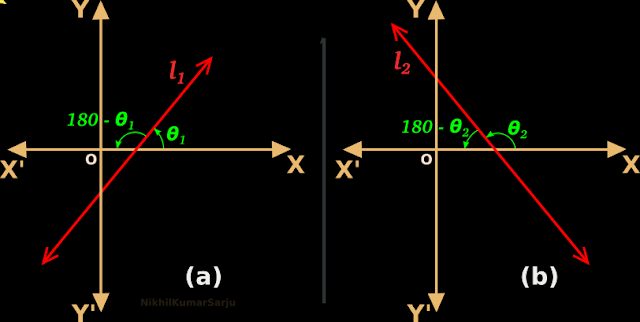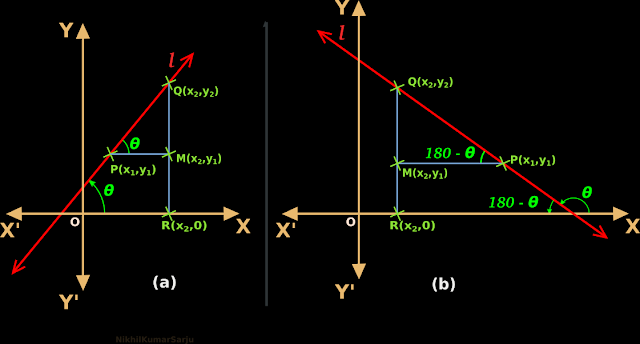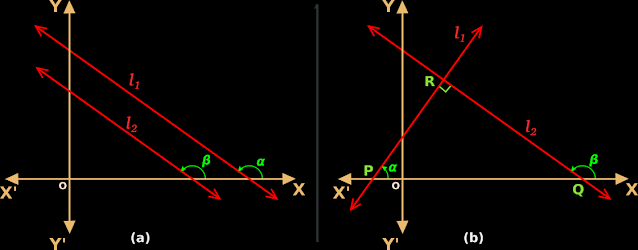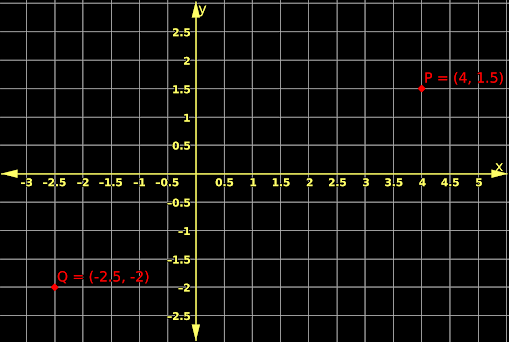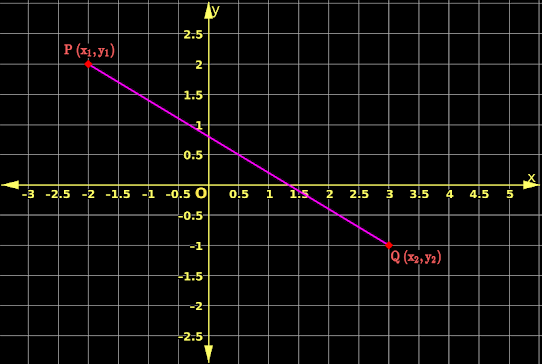In the previous section, we saw slope and inclination of lines. In this section, we will see angle between two lines.
•
Consider two lines lying in a plane. One of the following two possibilities will always occur:
(i) The two lines are parallel.
♦ They will never intersect.
(ii) The two lines are non-parallel
♦ Two non-parallel lines will surely intersect at a point.
•
Two non-parallel lines may be lying far away from each other. But if we extend them suitably, they will surely intersect at a point.
•
When two lines intersect, an angle will be formed between them.
•
It is possible to find that angle using the slopes of the lines. Let us see how it is done. It can be written in 5 steps:
1. Fig.10.8(a) below shows two non-vertical lines L1 and L2.
♦ L1 has an inclination of 𝛼
♦ L2 has an inclination of β
♦ The slope of L1 is m1
♦ The slope of L2 is m2
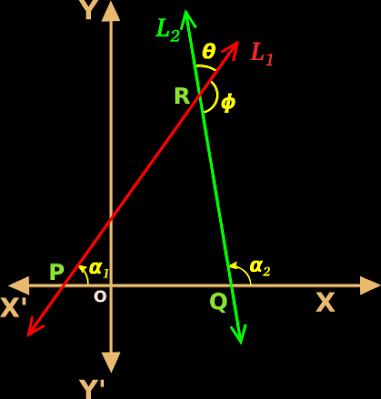 |
| Fig.10.8 |
2. Formation of triangle PQR:
♦ L1 and L2 intersect at R.
♦ L1 intersect the x-axis at P
♦ L2 intersect the x-axis at Q
• Thus we get a right angled triangle PQR
3. Formation of two angles:
• L1 and L2 intersect at R. The angle formed at R is marked as 𝜃.
• When 𝜃 is formed, another angle ɸ is also formed at the point of intersection.
• We see that: 𝜃 + ɸ = 180o
4. Relation between 𝛼1, 𝛼2 and 𝜃:
• 𝛼2 is an exterior angle of the triangle PQR
• For this exterior angle 𝛼2, the angles 𝛼1 and ∠PRQ are remote interior angles.
♦ ∠PRQ and 𝜃 are opposite angles
♦ So ∠PRQ = 𝜃
• Then we get: 𝛼2 = 𝛼1 + 𝜃
Which is same as: 𝜃 = 𝛼2 - 𝛼1
• This result can be used to find a relation between 𝜃, m1 and m2:
$\begin{array}{ll}
{}&{\theta}
&{}={}& {\alpha_2 - \alpha_1}
&{}& {}
&{}& {}
&{}& {}&{}& {} &{} &{} &{} \\
{\Rightarrow}&{\tan \theta}
&{}={}& {\tan (\alpha_2 - \alpha_1)}
&{}& {}
&{}& {}
&{}& {}&{}& {} &{} &{} &{} \\
{\Rightarrow}&{\tan \theta}
&{}={}& {\frac{\tan \alpha_2~-~\tan \alpha_1}{1~+~\tan \alpha_1 \tan \alpha_2}}
&{\color {green}{\text{- - - (a) }}}& {}
&{}& {}
&{}& {}&{}& {} &{} &{} &{} \\
{\Rightarrow}&{\tan \theta}
&{}={}& {\frac{m_2~-~m_1}{1~+~m_1 m_2}}
&{\color {green}{\text{- - - (b) }}}& {}
&{}& {}
&{}& {}&{}& {} &{} &{} &{} \\
\end{array}$
◼ Remarks:
(i) Line marked as (a):
See identity 11 in the list of identities.
(ii) Line marked as (b):
♦ tan 𝛼1 is m1
♦ tan 𝛼2 is m2
5. Using this relation, we can find 𝜃
Let us see an example:
Solved example 2
Two lines lying in the XY-plane have slopes $\frac{1}{2}$ and 3. Find the angle between them.
Solution:
1. Let m1 = $\frac{1}{2}$ and m2 = 3
•
We are asked to find 𝜃
2. We have the equation: $\tan \theta~=~\frac{m_2~-~m_1}{1~+~m_1 m_2}$
•
Substituting the known values, we get:
$\begin{array}{ll}
{}&{\tan \theta}
&{}={}& {\frac{3~-~\frac{1}{2}}{1~+~\frac{1}{2} × 3}}
&{} \\
{\Rightarrow}&{\tan \theta}
&{}={}& {\frac{6 ~-~1}{2~+~3}}
&{} \\
{\Rightarrow}&{\tan \theta}
&{}={}& {\frac{5}{5}}
&{} \\
{\Rightarrow}&{\tan \theta}
&{}={}& {1}
&{} \\
\end{array}$
3. This is a trigonometrical equation. We have learned how to solve them in a previous chapter (see solved example 3.65 in section 3.17).
2. Given that: tan 𝜃 = 1
•
We know that 45o is a principal solution.
• That means, we can put 45o in place of 𝜃.
3. We will now find another principal solution.
•
We have seen that, 𝜃 = 45o is a principal solution.
• When the input 𝜃 is 45o, the left side becomes tan 45o
• This gives us: tan 𝜃 = tan 45o = 1
•
We want another angle such that, it's tangent is also 1
• Such an angle can be calculated using identities 9.f and 9.e [See the list of identities]: tan (π+x) = tan x
• We get:
tan 45o = tan (180o + 45o) = tan 225o
•
So we can write:
tan 𝜃 = tan 45o = tan 225o
•
Picking the first and last items, we get:
𝜃 = 225o
♦ 225o is greater than 0o
♦ 225o is less than 360o also.
♦ So it can be accepted as a principal solution.
•
Thus we have two principal solutions for 𝜃:
𝜃 = 45o and 𝜃 = 225o
4. Fig.10.9 below shows how the two angles 45o and 225o are related to the given lines.
 |
| Fig.10.9 |
• The red line has a slope of $\frac{1}{2}$
Two convenient points points A and B are marked on this line.
• The green line has a slope of 3
Two convenient points points C and D are marked on this line.
• The two lines intersect at E
• ∠AEC (measured in the anti-clockwise direction) is the angle between the two lines. It's value is 45o
• ∠BEC (measured in the anti-clockwise direction) is also an angle between the two lines. It's value is (180 + 45) = 225o
5. In step (1), we took m1 = $\frac{1}{2}$ and m2 = 3.
• Since the order is not specified, we can take the reverse order also.
♦ That is., we interchange m1 and m2.
• Let us see if there is any change in the angles when we do the interchange. The following steps from (6) to (11) will give us the angles.
6. Let m1 = 3 and m2 = $\frac{1}{2}$
• We are asked to find 𝜃
7. We have the equation: $\tan \theta~=~\frac{m_2~-~m_1}{1~+~m_1 m_2}$
• Substituting the known values, we get:
$\begin{array}{ll}
{}&{\tan \theta}
&{}={}& {\frac{\frac{1}{2}~-~3}{1~+~ 3 × \frac{1}{2}}}
&{} \\
{\Rightarrow}&{\tan \theta}
&{}={}& {\frac{1~-~6}{2~+~3}}
&{} \\
{\Rightarrow}&{\tan \theta}
&{}={}& {-\frac{5}{5}}
&{} \\
{\Rightarrow}&{\tan \theta}
&{}={}& {-1}
&{} \\
\end{array}$
8. This is a trigonometrical equation. We have learned how to solve them in a previous chapter (see solved example 3.65 in section 3.17).
9. Given that: tan 𝜃 = -1
•
We know that 135o is a principal solution.
• That means, we can put 135o in place of 𝜃.
10. We will now find another principal solution.
•
We have seen that, 𝜃 = 135o is a principal solution.
• When the input 𝜃 is 135o, the left side becomes tan 135o
• This gives us: tan 𝜃 = tan 135o = -1
•
We want another angle such that, it's tangent is also -1
• Such an angle can be calculated using identities 9.f and 9.e: tan (π+x) = tan x
• We get:
tan 135o = tan (180o + 135o) = tan 315o
•
So we can write:
tan 𝜃 = tan 135o = tan 315o
•
Picking the first and last items, we get:
𝜃 = 315o
♦ 315o is greater than 0o
♦ 315o is less than 360o also.
♦ So it can be accepted as a principal solution.
•
Thus we have two principal solutions for 𝜃:
𝜃 = 135o and 𝜃 = 315o
11. Fig.10.10 below shows how the two angles 135o and 315o are related to the given lines.
 |
| Fig.10.10 |
•
The red line has a slope of $\frac{1}{2}$
Two convenient points points A and B are marked on this line.
•
The green line has a slope of 3
Two convenient points points C and D are marked on this line.
•
The two lines intersect at E
•
∠DEA (measured in the anti-clockwise direction) is the angle between the two lines. It's value is 135o
•
∠DEB (measured in the anti-clockwise direction) is also an angle between the two lines. It's value is (∠DEA + ∠AEC + ∠CEB) = (135 + 45 +135) = 315o
12. The figs.10.9 and 10.10 are exactly the same. They appear different because, in the first fig, we marked the acute angle between the given lines. In the second fig., we marked the obtuse angle.
•
Based on this, we can write a conclusion. It can be written in 3 steps:
(i) First we find tan 𝜃 using the equation:
$\tan \theta~=~\frac{m_2~-~m_1}{1~+~m_1 m_2}$
(ii) If tan 𝜃 obtained is +ve, the 𝜃 so obtained is the acute angle between the given lines.
(iii) If tan 𝜃 obtained is -ve, the 𝜃 so obtained is the obtuse angle between the given lines.
Solved example 3
Two lines lying in the XY-plane have slopes $\frac{1}{2}$ and $-\frac{1}{3}$. Find the angle between them.
Solution:
1. Let m1 = $\frac{1}{2}$ and m2 = $-\frac{1}{3}$
•
We are asked to find 𝜃
2. We have the equation: $\tan \theta~=~\frac{m_2~-~m_1}{1~+~m_1 m_2}$
•
Substituting the known values, we get:
$\begin{array}{ll}
{}&{\tan \theta}
&{}={}& {\frac{-\frac{1}{3}~-~\frac{1}{2}}{1~+~\frac{1}{2} × -\frac{1}{3}}}
&{} \\
{\Rightarrow}&{\tan \theta}
&{}={}& {\frac{-2 ~-~3}{6~-~1}}
&{} \\
{\Rightarrow}&{\tan \theta}
&{}={}& {\frac{-5}{5}}
&{} \\
{\Rightarrow}&{\tan \theta}
&{}={}& {-1}
&{} \\
\end{array}$
3. This is a trigonometrical equation. We have learned how to solve them in a previous chapter (see solved example 3.65 in section 3.17).
2. Given that: tan 𝜃 = -1
•
We know that 135o is a principal solution.
• That means, we can put 135o in place of 𝜃.
3. We will now find another principal solution.
•
We have seen that, 𝜃 = 135o is a principal solution.
• When the input 𝜃 is 135o, the left side becomes tan 135o
• This gives us: tan 𝜃 = tan 135o = -1
•
We want another angle such that, it's tangent is also -1
• Such an angle can be calculated using identities 9.f and 9.e [See the list of identities]: tan (π+x) = tan x
• We get:
tan 135o = tan (180o + 135o) = tan 315o
•
So we can write:
tan 𝜃 = tan 135o = tan 315o
•
Picking the first and last items, we get:
𝜃 = 315o
♦ 315o is greater than 0o
♦ 315o is less than 360o also.
♦ So it can be accepted as a principal solution.
•
Thus we have two principal solutions for 𝜃:
𝜃 = 135o and 𝜃 = 315o
4. Fig.10.11 below shows how the two angles 135o and 315o are related to the given lines.
 |
| Fig.10.11 |
• The red line has a slope of $\frac{1}{2}$
Two convenient points points A and B are marked on this line.
• The green line has a slope of $-\frac{1}{3}$
Two convenient points points C and D are marked on this line.
• The two lines intersect at E
• ∠BEC (measured in the anti-clockwise direction) is the angle between the two lines. It's value is 135o
• ∠BED (measured in the anti-clockwise direction) is also an angle between the two lines. It's value is (∠BEA + ∠AED) = (180 + 135) = 315o
5. In step (1), we took m1 = $\frac{1}{2}$ and m2 = $-\frac{1}{3}$.
• Since the order is not specified, we can take the reverse order also.
• Since the order is not specified, we can take the reverse order also.
♦ That is., we interchange m1 and m2.
• Let us see if there is any change in the angles when order is reversed. The following steps from (6) to (11) will give us the angles.
6. Let m1 = $-\frac{1}{3}$ and m2 = $\frac{1}{2}$
• We are asked to find 𝜃
7. We have the equation: $\tan \theta~=~\frac{m_2~-~m_1}{1~+~m_1 m_2}$
• Substituting the known values, we get:
$\begin{array}{ll}
{}&{\tan \theta}
&{}={}& {\frac{\frac{1}{2}~-~-\frac{1}{3}}{1~+~ -\frac{1}{3} × \frac{1}{2}}}
&{} \\
{\Rightarrow}&{\tan \theta}
&{}={}& {\frac{3~+~2}{6~-~1}}
&{} \\
{\Rightarrow}&{\tan \theta}
&{}={}& {\frac{5}{5}}
&{} \\
{\Rightarrow}&{\tan \theta}
&{}={}& {1}
&{} \\
\end{array}$
8. This is a trigonometrical equation. We have learned how to solve them in a previous chapter (see solved example 3.65 in section 3.17).
9. Given that: tan 𝜃 = 1
•
We know that 45o is a principal solution.
• That means, we can put 45o in place of 𝜃.
10. We will now find another principal solution.
•
We have seen that, 𝜃 = 45o is a principal solution.
• When the input 𝜃 is 45o, the left side becomes tan 45o
• This gives us: tan 𝜃 = tan 45o = 1
•
We want another angle such that, it's tangent is also 1
• Such an angle can be calculated using identities 9.f and 9.e: tan (π+x) = tan x
• We get:
tan 45o = tan (180o + 45o) = tan 225o
•
So we can write:
tan 𝜃 = tan 45o = tan 225o
•
Picking the first and last items, we get:
𝜃 = 225o
♦ 225o is greater than 0o
♦ 225o is less than 360o also.
♦ So it can be accepted as a principal solution.
•
Thus we have two principal solutions for 𝜃:
𝜃 = 45o and 𝜃 = 225o
11. Fig.10.12 below shows how the two angles 45o and 225o are related to the given lines.
 |
| Fig.10.12 |
• The red line has a slope of $\frac{1}{2}$
Two convenient points points A and B are marked on this line.
• The green line has a slope of $-\frac{1}{3}$
Two convenient points points C and D are marked on this line.
• The two lines intersect at E
• ∠CEA (measured in the anti-clockwise direction) is the angle between the two lines. It's value is 45o
• ∠CEB (measured in the anti-clockwise direction) is also an angle between the two lines. It's value is (CEA + 180) = (45 +180) = 225o
12. The figs.10.11 and 10.12 are exactly the same. They appear different because, in the first fig, we marked the obtuse angle between the given lines. In the second fig., we marked the acute angle.
• Based on this, we can write the same conclusion that we wrote in the previous solved example. It can be written in 3 steps:
(i) First we find tan 𝜃 using the equation:
$\tan \theta~=~\frac{m_2~-~m_1}{1~+~m_1 m_2}$
(ii) If tan 𝜃 obtained is +ve, the 𝜃 so obtained is the acute angle between the given lines.
(iii) If tan 𝜃 obtained is -ve, the 𝜃 so obtained is the obtuse angle between the given lines.
In the next section, we will see a few more solved examples.
